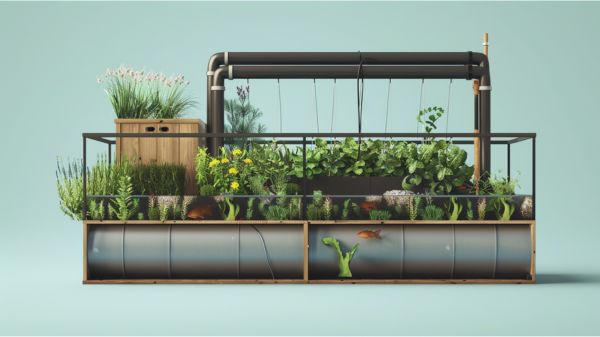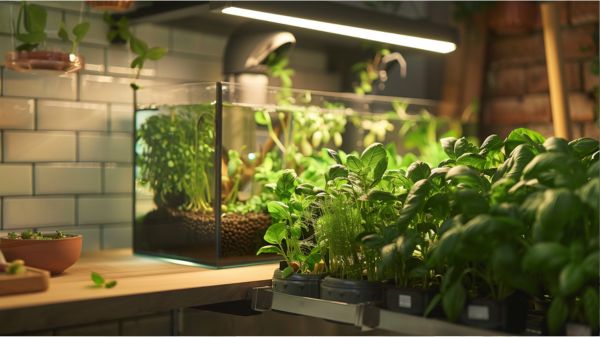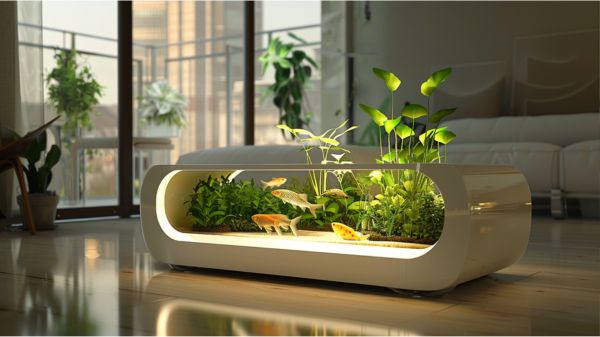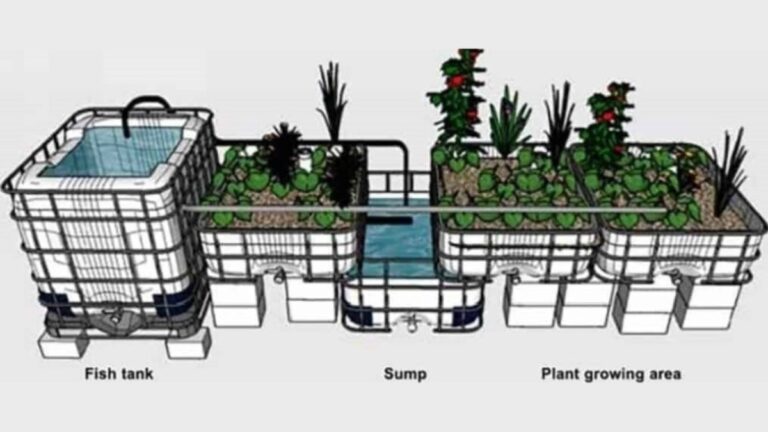7 Best Aquaponic System Components Checklist for Beginners
Equipping yourself with the right components is key to your aquaponic system success. Imagine setting up your aquaponic system with ease and efficiency, starting with the essential fish tanks and grow beds. But wait, there’s more to discover beyond these basics. In this post, we’ll be discussing the essential aquaponic system components checklist as your initial guide to your aquaponics journey.
From pumps to lighting, each component plays a crucial role in the harmony of your aquaponic ecosystem. As you navigate through this “7 Best Aquaponic System Components Checklist for Beginners”, you’ll uncover the foundation for a flourishing aquaponics system awaiting your touch of green-thumb finesse.

Key Takeaways
- Choose hardy fish like goldfish and guppies for adaptability.
- Opt for a suitable grow bed size based on plant selection.
- Select media with good water retention and aeration for efficiency.
- Maintain balanced pH levels and monitor system cycling for stability.
Fish Selection
When selecting fish for your aquaponic system, prioritize hardiness to ensure a forgiving and manageable experience as a beginner.
- Hardy fish species like goldfish, guppies, and angelfish are excellent choices due to their adaptability to different water conditions and ease of maintenance.
- Goldfish, in particular, are well-loved for their forgiving nature and ability to thrive in various environments with minimal intervention.
- Guppies, known for their small size, vibrant colors, and cost-effectiveness, are another beginner-friendly option.
- Angelfish not only add visual appeal to your setup but also can tolerate a range of water parameters, making them suitable for those new to aquaponics.
Choosing these hardy fish will set you up for success in your aquaponic journey.
Related Post: The Best Fish for Aquaponics System.
Grow Bed Setup
When setting up your grow bed for aquaponics, consider the size carefully to ensure it accommodates your plant selection. Choose the appropriate media like gravel or clay pebbles to support plant roots effectively. Establish a reliable drainage system to maintain proper water flow within the grow bed.
Bed Size Considerations
For optimal plant root growth and nutrient absorption in your aquaponic system, consider a grow bed size of at least 12-15 inches deep. Larger grow beds provide more surface area for beneficial bacteria to thrive, converting fish waste into plant nutrients efficiently.
Adequate grow bed size ensures proper water filtration and nutrient distribution, promoting healthy plant growth. Smaller grow beds may limit plant variety and growth potential due to restricted root space and nutrient availability.
Properly sizing the grow bed in relation to the fish tank is crucial for a balanced aquaponics system, facilitating efficient nutrient cycling.
- Larger grow beds support thriving beneficial bacteria.
- Adequate grow bed size ensures proper water filtration.
- Proper sizing promotes healthy plant growth.
Media Selection Guide
Consider selecting a media with good water retention and aeration properties to optimize plant growth in your aquaponic system’s grow bed setup. Common media types like clay pebbles, gravel, or expanded shale work well.
Ensure the media has a neutral pH to support nitrifying bacteria and plant health. Look for media that offers ample surface area for beneficial bacteria to convert fish waste into nutrients for your plants.
Properly choosing and preparing the grow media is crucial for the efficiency and success of your aquaponic system. By focusing on water retention, aeration, and pH neutrality in your media selection, you can create an environment conducive to robust plant growth and thriving nitrifying bacteria, essential for the health of your aquaponics setup.
Drainage System Setup
To ensure efficient water drainage and regulation in your aquaponic system’s grow bed, creating a well-designed drainage system is essential. Here are key components to consider for optimal conditions:
- Bell Siphon System: Use a bell siphon to regulate water levels and prevent overflooding in the grow bed.
- Standpipe Installation: Install a standpipe to control the water level and maintain suitable conditions for plant roots.
- Choosing Suitable Grow Media: Select appropriate grow media such as clay pebbles or gravel that facilitate efficient water circulation and drainage.
Water Pump Installation
When installing the water pump in your aquaponic system, pay attention to the pump power requirements to ensure adequate water circulation.
Proper pump placement is crucial for efficient water flow within the system, promoting oxygenation and nutrient distribution. Remember to follow pump maintenance tips regularly to prevent clogging and maintain optimal performance.
Pump Power Requirements
For optimal water circulation and oxygenation in your aquaponic system, ensure the water pump you select matches the power requirements suitable for your system size. When considering the pump power requirements, remember to take into account factors such as water volume, head height, and flow rate.
Opting for energy-efficient water pumps not only helps in reducing operating costs but also promotes sustainability. Proper installation of the water pump is crucial to maintain optimal water circulation within the system.
Additionally, regular maintenance checks are essential to prevent clogging or malfunctions in your aquaponic setup. Stay mindful of these aspects to ensure your aquaponic system operates efficiently and effectively.
- Consider water volume, head height, and flow rate
- Opt for energy-efficient pumps
- Ensure proper installation and regular maintenance
Proper Pump Placement
Placing the water pump at the bottom of the fish tank ensures efficient water circulation throughout the aquaponic system, promoting oxygenation and even distribution of nutrients to the plants.
Proper pump placement helps prevent dead zones, ensuring the water is well-mixed, vital for maintaining a healthy system. To maintain consistent water flow and prevent displacement, securely fix the water pump in place.
Check out the table below for a quick summary of the key points regarding water pump placement:
| Key Points | Details |
|---|---|
| Placement | Bottom of the fish tank |
| Circulation | Ensures efficient water circulation |
| Oxygenation | Promotes oxygenation of water |
| Nutrient Distribution | Ensures even distribution to plants |
| Prevent Dead Zones | Avoid stagnant areas in the system |
Pump Maintenance Tips
To ensure optimal functionality and longevity of your aquaponic system, implementing proper water pump maintenance is essential. When it comes to maintaining water pumps, here are some key tips to follow:
- Regularly inspect water pump components to ensure proper functioning.
- Clean the water pump intake to prevent clogs and maintain optimal water flow.
- Use energy-efficient water pumps to minimize electricity costs and ensure continuous operation.
Plant Types for Aquaponics
Leafy greens, herbs, and fruiting plants are popular choices for aquaponic systems due to their adaptability and nutrient requirements. When selecting plants for your aquaponic setup, consider options like lettuce, basil, tomatoes, arugula, and carrots.
These plants thrive in aquaponic environments and offer a range of flavors and harvest possibilities. While leafy greens and herbs tend to excel in aquaponics due to their fast growth and nutrient density, fruiting plants like tomatoes can also flourish with proper care.
Microgreens, such as arugula and radish, are nutrient-dense options that are quick to grow, perfect for continuous harvesting. Root vegetables like carrots can be more challenging but are still viable with careful attention.
| Category | Plants |
|---|---|
| Leafy Greens | Lettuce, Arugula |
| Herbs | Basil, Mint |
| Fruiting Plants | Tomatoes, Peppers |
Aeration System Essentials
Ensuring aeration in your aquaponic system is paramount for maintaining optimal oxygen levels crucial for the well-being of your fish and the growth of your plants. To achieve this, consider the following essentials:
- Air Pump: A key component that pushes air into the water to increase oxygen levels.
- Air Stones: These help diffuse the oxygen throughout the water, ensuring it reaches all areas.
- Tubing: Used to connect the air pump to the air stones, facilitating the delivery of oxygen efficiently.
Proper aeration not only supports fish health but also promotes beneficial bacteria growth, aids in nutrient absorption by plant roots, enhances water circulation, reduces stress on fish, and ultimately boosts system productivity. Investing in a quality aeration system is crucial for beginners to set the foundation for a successful aquaponics journey.
Ph Monitoring Equipment
A crucial component for maintaining optimal pH levels in your aquaponic system is the use of reliable pH monitoring equipment. Digital pH meters offer accurate readings, aiding in precise monitoring within the optimal pH range of 6.8-7.2.
pH test kits with color indicators can also be utilized to measure water acidity or alkalinity. Regular monitoring and adjustment of pH levels are essential for the well-being of both fish and plants.
Keeping a balanced pH is vital for promoting nutrient uptake by plants and ensuring the overall success of your aquaponics system. By investing in quality pH monitoring equipment, you can effectively manage the pH levels, creating an environment where both aquatic life and plants thrive.
Cycling Your Aquaponic System
To successfully cycle your aquaponic system, initiate the process of establishing beneficial bacteria to convert fish waste into plant nutrients. Here are some key points to consider:
- Ammonia Spike: Kickstart the cycling process by introducing ammonia to encourage bacterial growth.
- Nitrite Decrease: Expect a spike in nitrite levels initially, followed by a decrease as nitrifying bacteria establish.
- Monitoring Levels: Regularly monitor levels of ammonia, nitrite, and nitrate to maintain a stable environment for both fish and plants.
Related Post: 7 Best Aquaponic Betta Fish Tanks for a Beautiful and Sustainable Home Aquarium.
Frequently Asked Questions
What Is the First Component Needed in an Aquaponic System?
In an aquaponic system, the first crucial component you need is a fish tank. It serves as the primary habitat for the fish, producing waste that supplies essential nutrients to the plants, laying the foundation for system balance.
What Is the Best Aquaponic System for Beginners?
For beginners, the best aquaponic system is the media bed setup. It offers a solid foundation for learning. Choose fish like tilapia and plants such as lettuce. Monitor water quality and nutrient levels. Maintain system design and follow maintenance tips.
What Do I Need to Start Aquaponics?
To start aquaponics, you need a fish tank, grow bed, water pump, and appropriate grow media. Choose a food-grade tank, 15-inch grow bed, right pump, and suitable media for plant roots and bacteria support.
What Are the 4 Main Parts of an Aquaponics System?
To sustain an aquaponics system, you need a grow bed to nurture plants, a fish tank for aquatic life, a water pump for circulation, a bell siphon for drainage, a media filter for purification, an air stone for aeration, a pH tester for monitoring, grow lights for illumination, a water heater for temperature control, and a nutrient solution for plant nourishment.

Conclusion
Now that you have carefully selected your fish, set up your grow beds, installed your water pump, chosen the right plants, ensured proper aeration, monitored pH levels, and cycled your aquaponic system, you’re well on your way to a successful and thriving garden.
With the right components and maintenance, your aquaponics system will continue to flourish, providing you with fresh produce and sustainable gardening joy.
Keep up the great work and enjoy the fruits of your labor!






